Wildlife Photographer of the Year (WPY) is always a huge highlight in the photographic calendar. Developed and produced by the Natural History Museum, London, the prestigious competition always attracts the very best of the year’s wildlife photography, and of course 2025 is no different. Striving to inspire a love for the natural world, generate public interest in conservation and enhance the prestige of wildlife photography, Wildlife Photographer of the Year is presented through an exhibition of incredible images of animals, their environments and the important photojournalism stories.
Now in its 61st year, entry records continue to be broken with 60,363 entries from across 113 countries and territories submitted. The 19 overall category winners, and Grand Title and Young Grand Title awards, were announced at a ceremony hosted by TV presenters and conservationists Chris Packham and Megan McCubbin.
South African wildlife photographer Wim van den Heever has been announced as the overall winner with a ghostly image of a rare brown hyena in a deserted diamond mining town.
Open from 17th October 2025, The Wildlife Photographer of the Year 61 exhibition is on show at Natural History Museum in South Kensington, London until 12th July 2026, and will show a selection of 100 photographs – including the winners we share here.
Entries to the 62nd Wildlife Photographer of the Year open on 20th October and close 11:30am GMT on 4th December 2025. Photographers aged 26 and under can enter for free. Visit nhm.ac.uk/wpy/competition for more information.
Now, let’s look at the winners…
Winner, Urban Wildlife and Wildlife Photographer of the Year 2025: Ghost Town Visitor by Wim van den Heever, South Africa
Nikon D810 + 17–35mm f2.8 lens at 17mm; 15 at f2.8; ISO 3200; 2x Nikon SB-800 Speedlight flashes; Camtraptions motion sensor
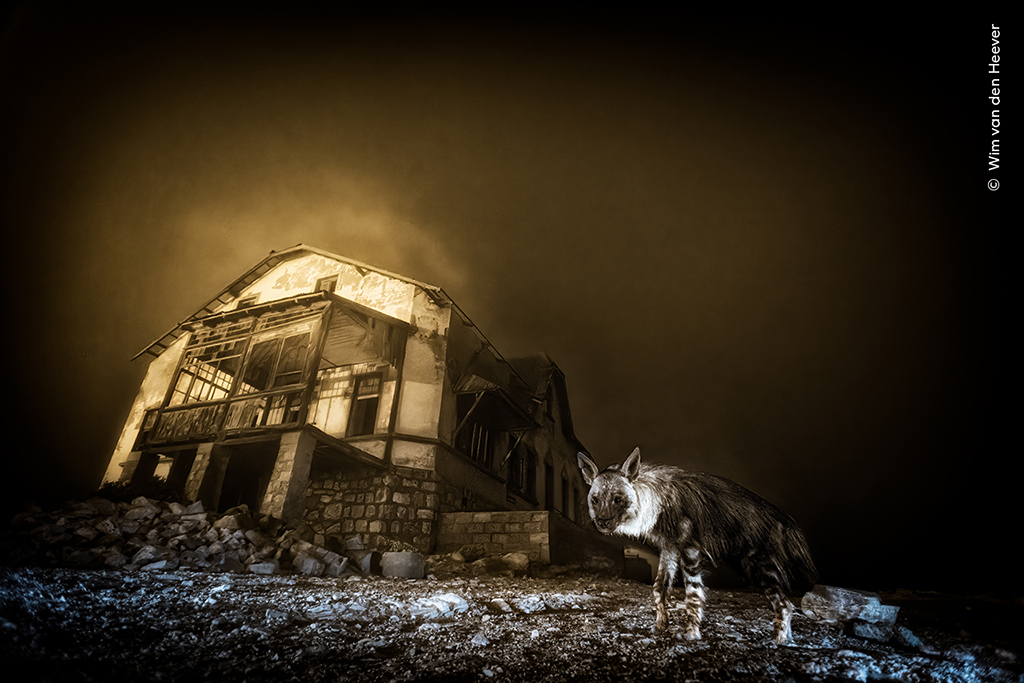
Wim’s van den Heever’s winning photograph is a haunting scene of a rare brown hyena among the remains of a long-abandoned diamond mining town in Kolmanskop, Namibia. After first noticing hyena tracks nearby, Wim chose this spot for his camera trap. He said, ‘It took me 10 years to finally get this one single image of a brown hyena, in the most perfect frame imaginable.’
The brown hyena is the rarest of the hyena species, nocturnal and mostly solitary – so Wim’s patience and dedication is admirable. They are known to pass through Kolmanskop on their way to hunt Cape fur seal pups or scavenge for carrion washed ashore along the Namib Desert coast. ‘My photograph captures a simple idea – that wildlife isn’t something distant or separate from us. Even in our cities and urban areas nature finds a way to live alongside us, to remind us that coexistence is possible if we choose to see it.’ With sea fog rolling in from the Atlantic Ocean, the result is incredibly atmospheric.
Winner, 15 – 17 Years and Young Wildlife Photographer of the Year 2025: After the Destruction by Andrea Dominizi, Italy
Nikon D7100 + Tokina 10–17mm f3.5–4.5 fisheye lens at 17mm; 1/80 at f8; ISO 400; Godox TT350 off-camera flash and diffuser
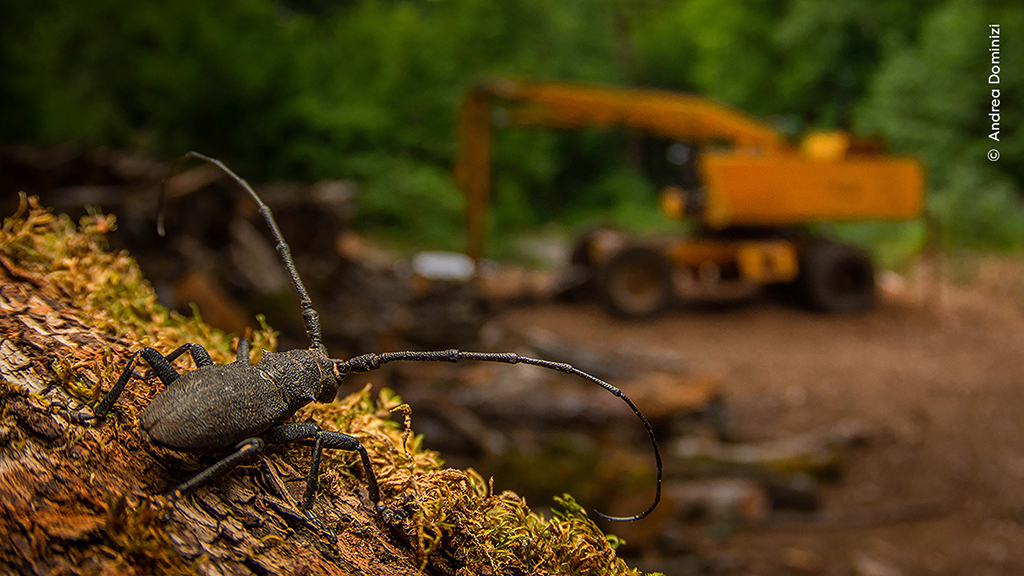
Andrea is the first Italian to win the prestigious Young Wildlife Photographer of the Year award, for photographers aged 17 and under. Andrea noticed this longhorn beetle while walking in the Lepini Mountains of central Italy, in an area once logged for old beech trees. Framed against abandoned machinery, he used a wide-angle lens and off-camera flash.
Andrea’s photograph tells a poignant story of habitat loss. As longhorn beetles tunnel into dead wood, fungi make their way inside, helping to break it down and recycle nutrients. If the beetles’ habitat is disturbed or destroyed, the effects ripple across the entire ecosystem.
‘I entered into Wildlife Photographer of the Year without any big expectations, but with a bit of hope, hope that my work could be seen by the whole world.’ Andreas’ win proves you don’t need to travel far to take award-winning photography, ‘when I read the email with my result it was unbelievable, a great emotion, especially living in a little suburban city and with a photo taken of a “simple” subject in a “simple” woods near my home.’
Winner, Animals in their Environment: Like an Eel out of Water by Shane Gross, Canada
Nikon Z6 + 24–70mm lens at 24mm; 1/250 at f5.6; ISO 2500; Godox AD400 Pro flash with 24-inch diffuser; light stand
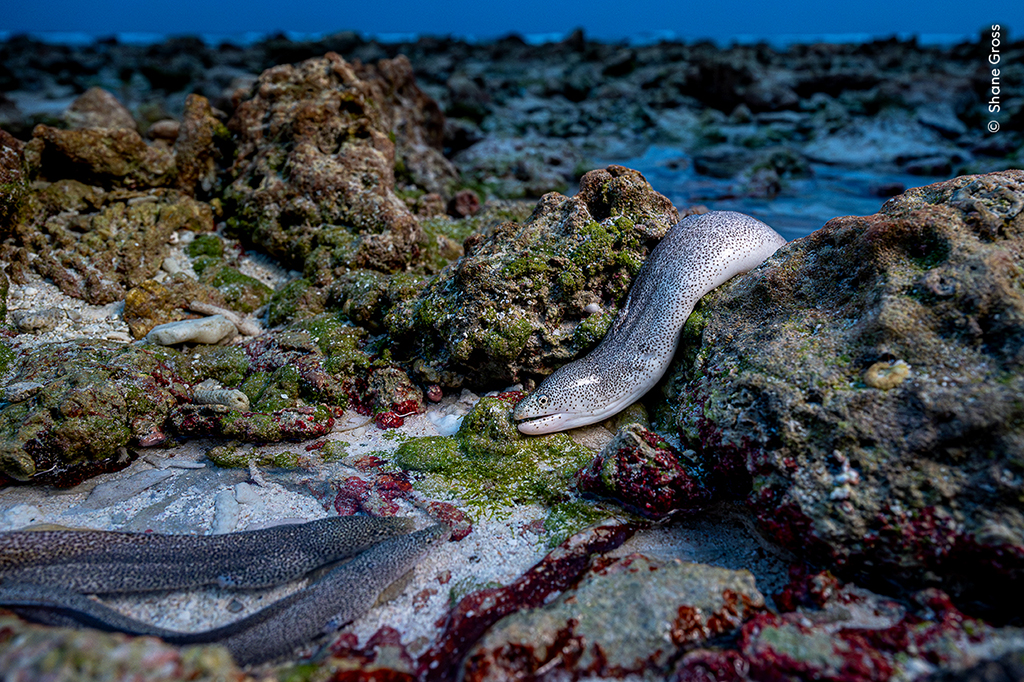
Shane’s photo shows a peppered moray eel hunting for carrion at low tide. It took him numerous attempts over several weeks to document this rarely photographed behaviour. At first the eels were elusive, but once Shane realised that they were scavenging for dead fish, he waited. His patience was soon rewarded when these three eels appeared.
Winning this category means a lot to previous Wildlife Photographer of the Year winner Shane, ‘I’m so happy to win the Animals in their Environment category because it means millions of people will get to see and learn about Spotted Moray Eels and the Marine Protected Area (MPA) that is allowing them to thrive.’
Peppered moray eels are well adapted to the intertidal zone. They can hunt both above and below the water’s surface using their keen senses of smell and sight, sometimes staying out of water for more than 30 seconds. ‘I entered this image because it was a behavior I had never heard about until I saw it for myself… Just amazing!’
Winner, Animal Portraits: Shadow Hunter by Philipp Egger, Italy
Nikon Z9 + 180–600mm f5.6–6.3 lens; 1/10 at f29; ISO 320

Philipp first saw this nest while climbing and spent four years observing it from a distance. He planned this image meticulously, right down to the slight camera wobble to blur the few elements present, using a telephoto lens. His patience was rewarded with the orange glint of an eagle owl’s eyes and the evening light falling perfectly on its feathers.
About twice the weight of a buzzard and with a wingspan approaching 180 centimetres (6 feet), these formidable nocturnal predators are among the largest owls. They nest on sheltered cliff ledges or in crevices, often returning to the same site for years.
Winner, Behaviour: Birds: Synchronised Fishing by Qingrong Yang, China
Nikon Z9 + 400mm f2.8 lens; 1/2500 at f5; ISO 110
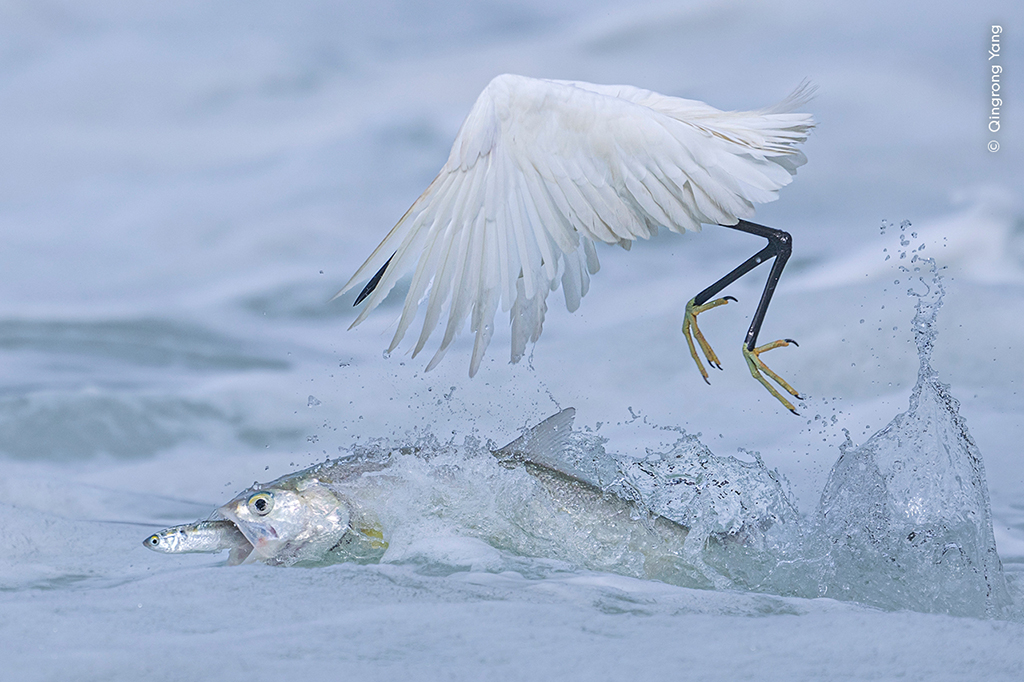
Qingrong was at Yundang Lake, a place he visits regularly near his home to photograph feeding frenzies. Little egrets patrol the surface, ready to pounce on fish leaping to escape underwater predators. In this photo Qingrong has captured the moment the ladyfish snatched its prey from a little egret’s beak.
Once a natural marine harbour, Yundang Lake was sealed off from the sea during 1970s development. Isolated from the tides and currents, it became polluted and stagnant. An engineering project later reconnected it to the sea via a system of gates that regulate water flow.
Winner, Behaviour: Mammals: Cat Amongst the Flamingos by Dennis Stogsdill, USA
Canon EOS-1D X Mark II + 600mm f4 lens; 1/1600 at f5.6; ISO 2500
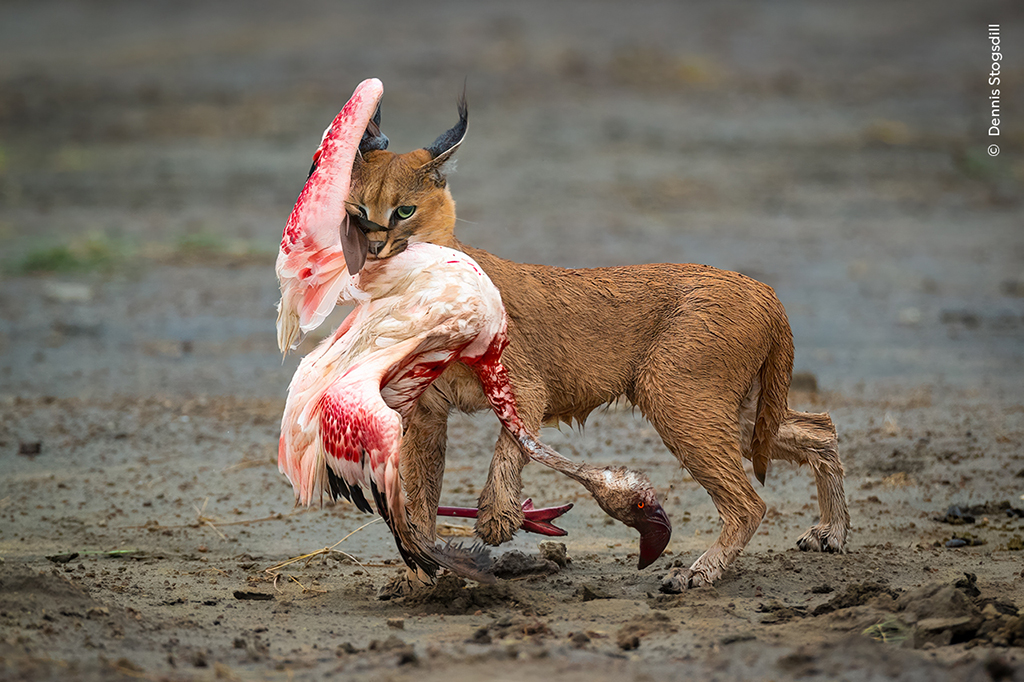
Dennis had been keeping an eye out for wild cats such as servals for several days in the Serengeti National Park, Tanzania, when a call came over the radio: one had been seen at Ndutu Lake. But it wasn’t a serval. It was a caracal, successfully hunting wading lesser flamingos.
Caracals have a varied diet, from insects to antelope, and are renowned for the acrobatic leaps they make to snatch birds from the air. But there are few, if any, records of them hunting flamingos.
Winner, Behaviour: Amphibians and Reptiles: Frolicking Frogs by Quentin Martinez, France
Canon EOS 7D Mark II + 17–40mm f4 lens at 24mm; 1/200 at f16; ISO 500; 4x Meike MK320 flashes; homemade softbox
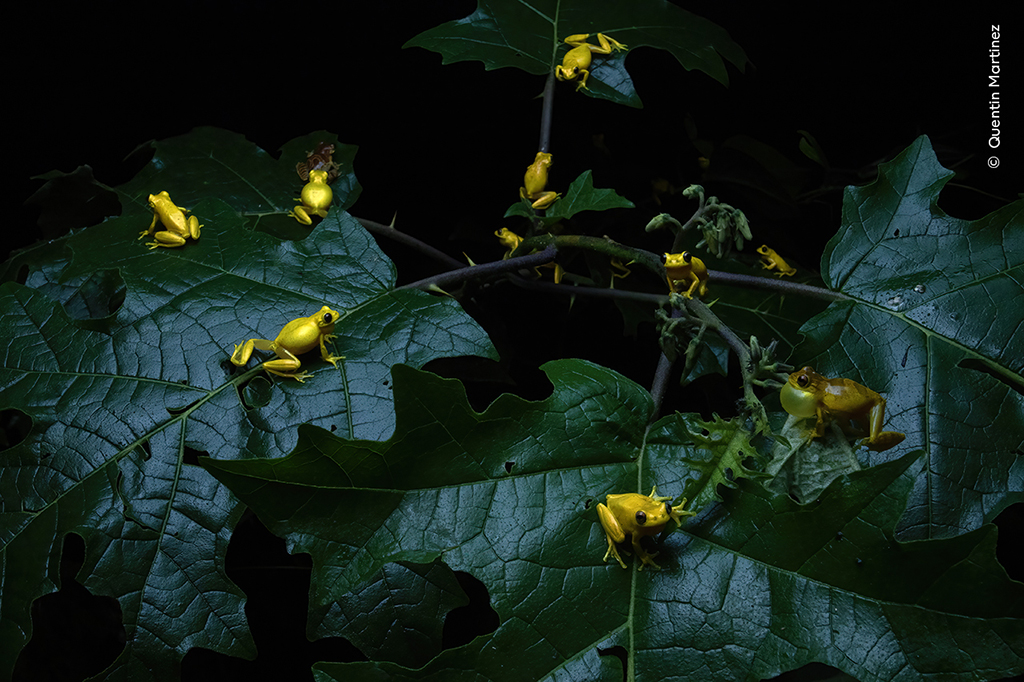
Quentin discovered a gathering of lesser tree frogs in a breeding event in the Kaw Mountain, French Guiana. In persistent rain, Quentin followed a flooded path to a temporary pool in a forest clearing. This scene was framed using a wide-angle lens and a diffused flash, which didn’t disturb the frogs, to highlight their metallic sheen.
To attract mates, lesser tree frogs produce short, shrill calls. Huge numbers gather, and the spectacular breeding event – triggered by heavy rains – lasts for just a few hours. Quintin told me, “Explosive breeding is the name of a rare phenomenon where frogs aggregate to reproduce in the same place at the same time. In some rare ponds and some years, several tens of thousands of individuals aggregate in the same area.” Having witnessed this event over 10 years ago in 2013, Quintin was transfixed by the magical moment and continued to return in hopes of documenting it – as they are a ‘right time, right place’ scenario there were some slight misses in timing along the way.
“My goal in submitting this photo to the competition was to somehow share a glimpse of what I experienced. Receiving such a prestigious award is truly amazing for me, but what I hope most is that it will spark curiosity and interest in frogs, especially among the younger generation.”
Winner, Behaviour: Invertebrates: Mad Hatterpillar by Georgina Steytler, Australia
Olympus OM-D E-M1 Mark III + 90mm f3.5 lens; 1/250 at f22; ISO 500; Godox flash
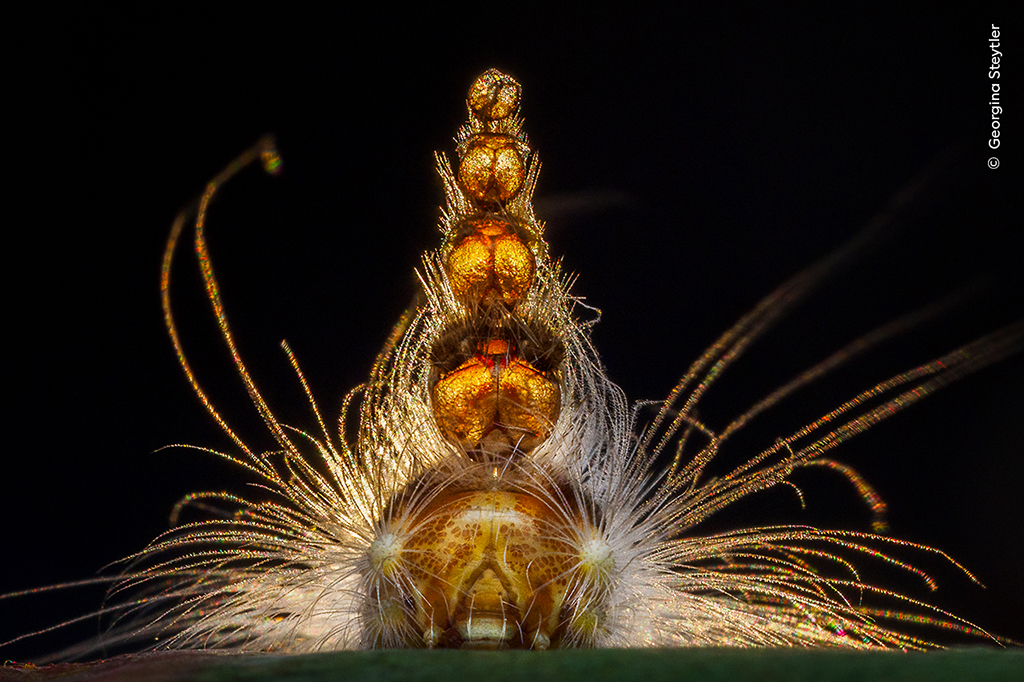
Georgina had been looking out for a gum-leaf skeletoniser caterpillar for years when she noticed eucalyptus trees bearing skeletonised leaves, telltale signs that the animal had been grazing. She took this image backlit by the setting sun, using a fill-in flash to illuminate the living head at the base of the stack. This image showcases the caterpillar’s unusual headgear, which is made up of old head capsules, each retained with every moult. The resulting tower is believed to help deflect attacks by predators.
About her winning image Georgina said, ‘I have always loved quirky, lesser-known animals so being able to showcase Australia’s Mad Hatterpillar to the world is a dream come true. However, my father died a few months ago and the look of pride on his face when I told him I had won is by far the greatest reward and something I will cherish forever.’
Winner, Oceans: The Bigger Picture: The Feast by Audun Rikardsen, Norway
Canon EOS R5 + 15–35mm f2.8 lens at 15mm; 1/200 at f4.5; ISO 10000; Canon Speedlite 600EX II flash; LED torch
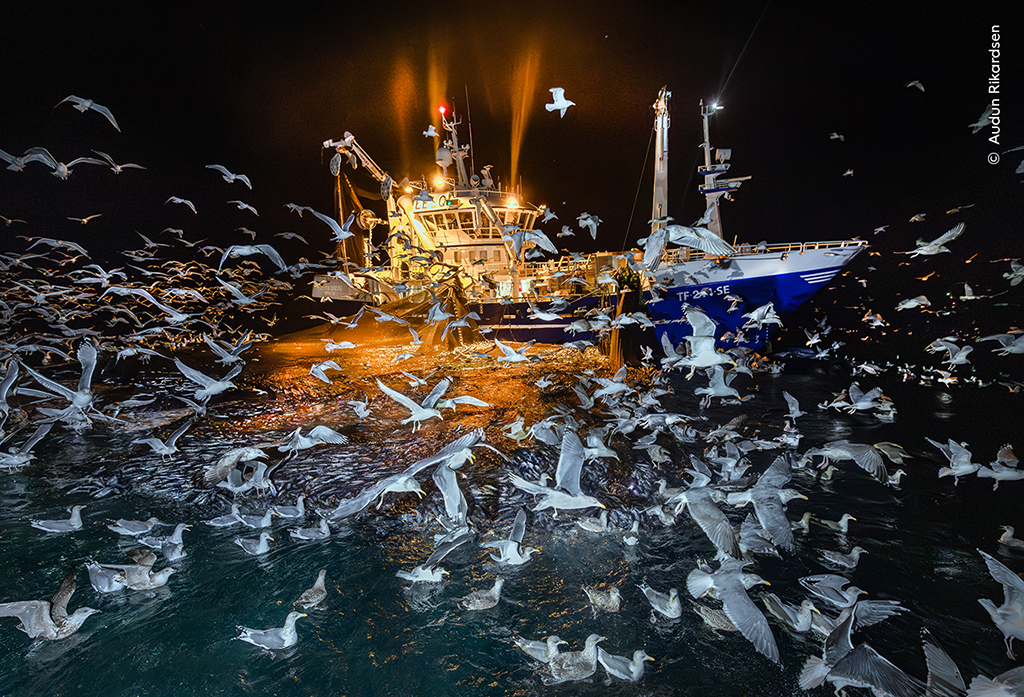
Audun photographed this chaotic scene of gulls attempting to catch fish trapped by nets around an Atlantic fishing vessel in northern Norway. The gulls have learnt to follow the sound of the boats to find a herring feast. Through his work, Audun aims to draw attention to the ongoing conflict between seabirds and the fishing industry.
Unfortunately, many birds drown in or around these purse seine nets each year. Various fisheries and researchers are trialling solutions, including sinking the nets more quickly to make them less accessible to the birds.
Winner, Plants and Fungi: Deadly Allure by Chien Lee, Malaysia
Nikon Z9 + Laowa 15mm f4 macro lens; 30 at f16; ISO 100; Convoy C8 ultraviolet torch
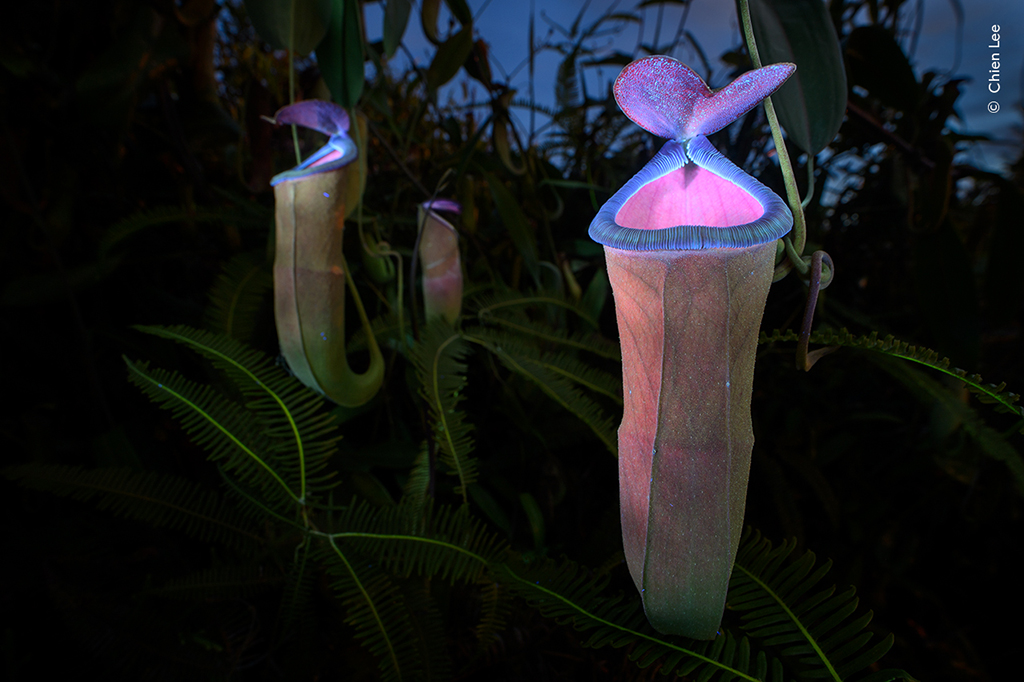
Some carnivorous pitcher plants reflect UV light on certain areas as part of their display to attract insects. They use colour, scent and nectar to lure their prey into pools of digestive juices at the bottom of their leaves. As insects can see UV light and humans cannot, Chien used a long exposure and ultraviolet torch to reveal the fluorescent world of an insect-attracting pitcher plant. Waiting until sunset, he had just a five-minute window before the ambient light illuminating the backdrop disappeared completely.
Winner, Natural Artistry: Caught in the Headlights by Simone Baumeister, Germany
Canon EOS R5 + Carl Zeiss Jena Pancolar 50mm f1.8 lens + 16mm extension tube; 1/250 at f2.8 (-1.33 e/v); ISO 1250
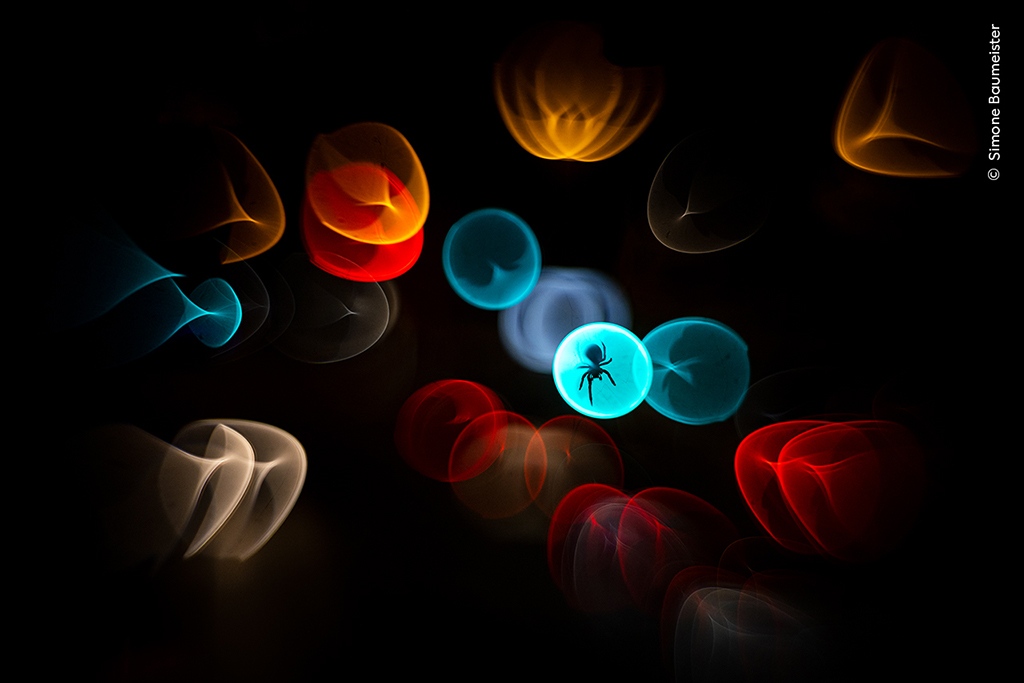
Simone shows an orb weaver spider on its web on a pedestrian bridge, silhouetted by lights from the cars below.To achieve this kaleidoscopic effect, Simone reversed one of the six glass elements in an analogue lens. This distorted the image at the edges while leaving the centre sharply focused. She then cropped the picture to move the spider slightly off-centre.
In urban environments, orb weaver spiders often spin webs near artificial lights that attract insects at night. The web acts as an extension of their sense organ, gathering sound and transmitting vibrations, including those of prey, to their legs.
Winner, Underwater: Survival Purse by Ralph Pace, USA
Nikon D850 + 28–70mm f3.5–4.5 lens; 1/125 at f14; ISO 640; Nauticam housing; 2x Sea & Sea strobes
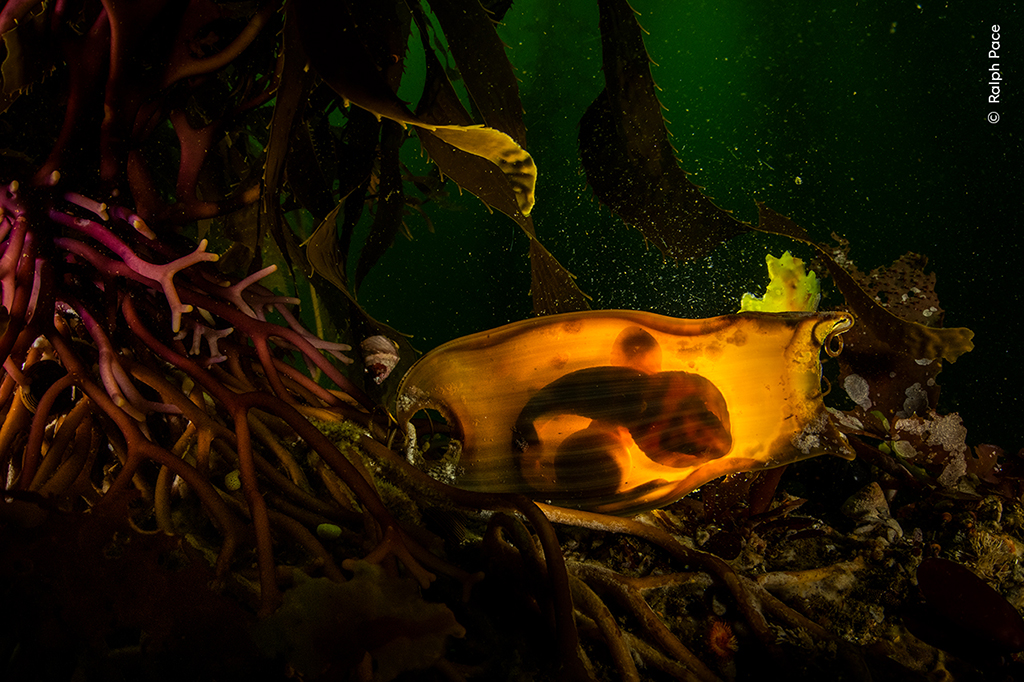
Ralph beautifully illuminates the egg case of a swell shark, tethered to the base of a giant kelp. Faced with strong currents pushing him from side to side, Ralph struggled to keep steady to photograph this egg case, or ‘mermaid’s purse’. He lit the case from behind to reveal the swell shark embryo within, its gill slits and yolk sac clearly visible among the dark kelp forest.
Researchers estimate that kelp forests in Monterey Bay have declined by more than 95 per cent over the past 34 years. Swell sharks depend on kelp to lay their leathery eggs, making them especially vulnerable to such losses.
Winner, Wetlands: The Bigger Picture: Vanishing Pond by Sebastian Frölich, Germany
Nikon Z7 + 105mm f2.8 lens; 1/800 at f9 (-1.67 e/v); ISO 400
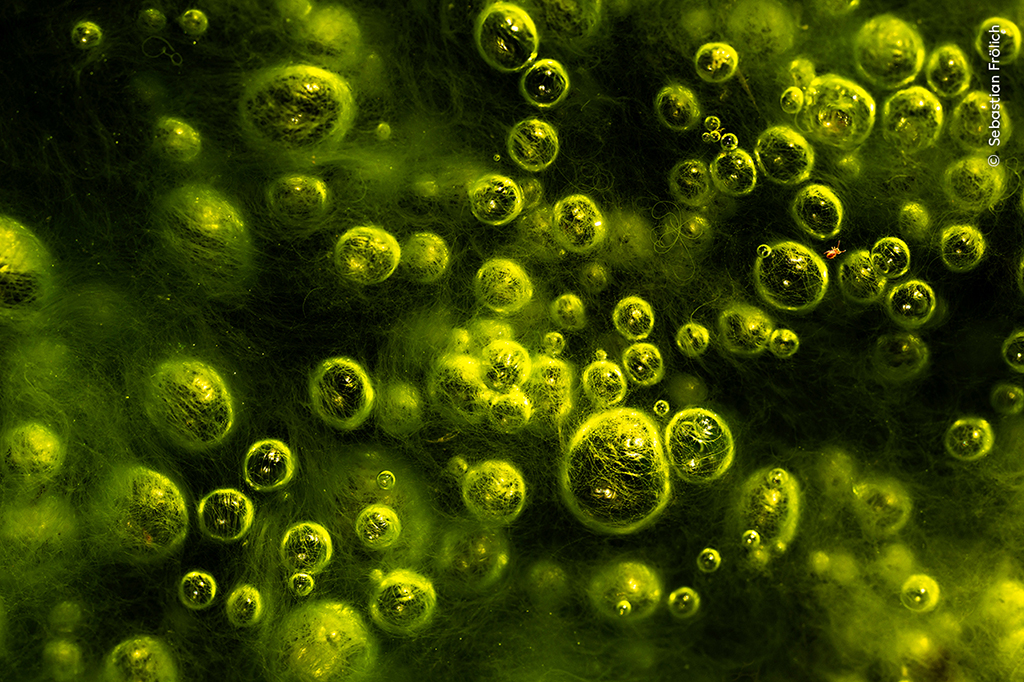
Sebastian visited the fragile Platzertal wetland ecosystem, one of the last intact high moorlands in the Austrian Alps, to highlight its importance as a vast store of carbon dioxide and as a habitat for diverse wildlife. The area is renowned for its carbon-storing peat bogs.
Austria has lost 90 per cent of its peat bogs, and only 10 per cent of those that remain are in good condition. A tiny springtail ran across escaping gas bubbles rising through the algae, giving this image an incredible sense of scale.
Winner, Photojournalism: How to Save a Species by Jon A Juárez, Spain
Nikon Z9 + 24–120mm f4 lens at 24mm; 1/400 at f7.1; ISO 1600; LED light panel
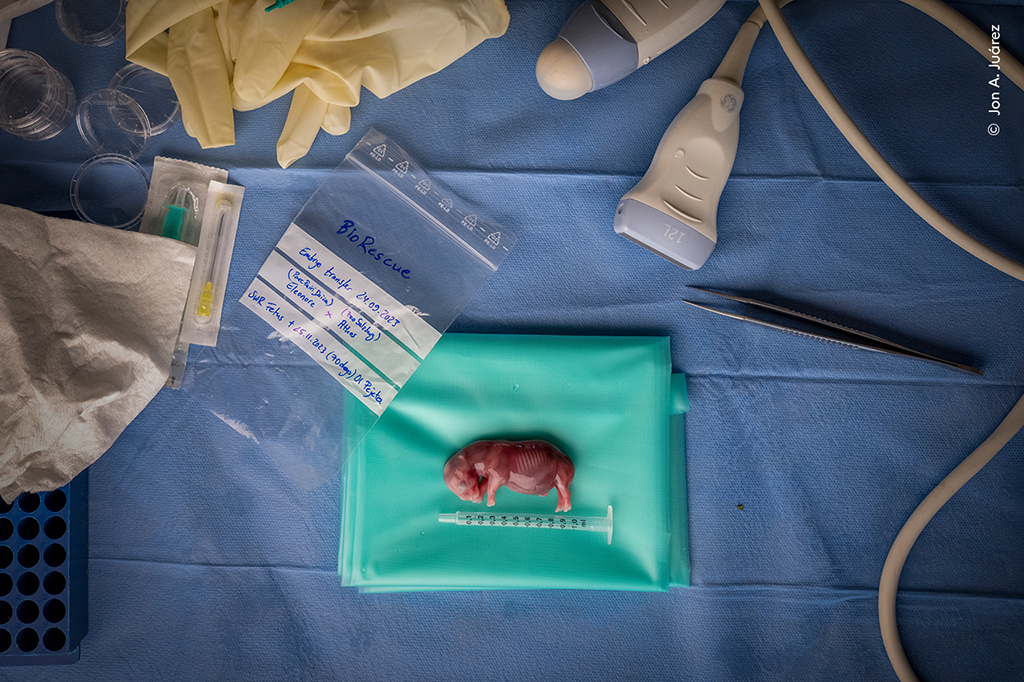
Jon spent years documenting the work of the BioRescue Project and says that witnessing a milestone in saving a species ‘was something I will never forget’. He documents the groundbreaking science to save the northern white rhino from extinction through in vitro fertilisation (IVF).
This southern white rhino foetus, which did not survive due to an infection, was the result of the first successful rhino embryo transfer into a surrogate mother through IVF. ‘Photographing it was both humbling and heartbreaking. It had the shape of a rhino already, even the place where the horn would sprout.’ This breakthrough paves the way for saving the rare northern white rhino from extinction, as scientists can take the next crucial steps towards transferring the first northern white rhino embryo into a southern white rhino surrogate.
On his award, Jon said, ‘To me, the WPY is not only a photo competition. It is one of the biggest platforms to spread important stories about nature and conservation. As photographers we can give a voice to those who are rarely heard, we can build bridges and help others understand what is going on around us. And being part of this, a family that unites the best photographers in the world, makes me extremely proud and happy.’
Impact Award Winner and Highly Commended, Photojournalism: Orphan of the Road by Fernando Faciole, Brazil
Nikon D850 + 24–70mm f2.8 lens at 28mm; 0.8 at f22; ISO 31; Nikon Speedlight flash with Greica CT-16 transmitter/receiver

The Impact Award is now in its second year and recognises conservation success and positive change. Fernando’s ‘Orphan of the Road’ is part of a long-term project highlighting the consequences of road collisions, a leading cause of the decline in giant anteater numbers in Brazil. The photo shows an orphaned giant anteater pup follow its caregiver after an evening feed at a rehabilitation centre. This pup’s mother was killed by a vehicle, and the hope is that it will be released back into the wild after being encouraged to develop crucial survival skills by its caregiver.
Fernando said, “It’s my favourite image from the story because I can spark different emotions with it… I also like it because of the technical challenge. I used a rear flash with a slow shutter speed to bring movement into the frame and then froze the image afterwards.”
On winning the award he told me, “the Impact Award is an incredible opportunity to show the effect my images can have and to share the story of these animals with a broader audience.” Alongside the work of rehabilitation centres, the Anteaters and Highways project of the Wild Animal Conservation Institute is developing strategies to reduce anteater deaths on Brazil’s roads. These include erecting fences and building underground tunnels to allow the anteaters to cross safely.







